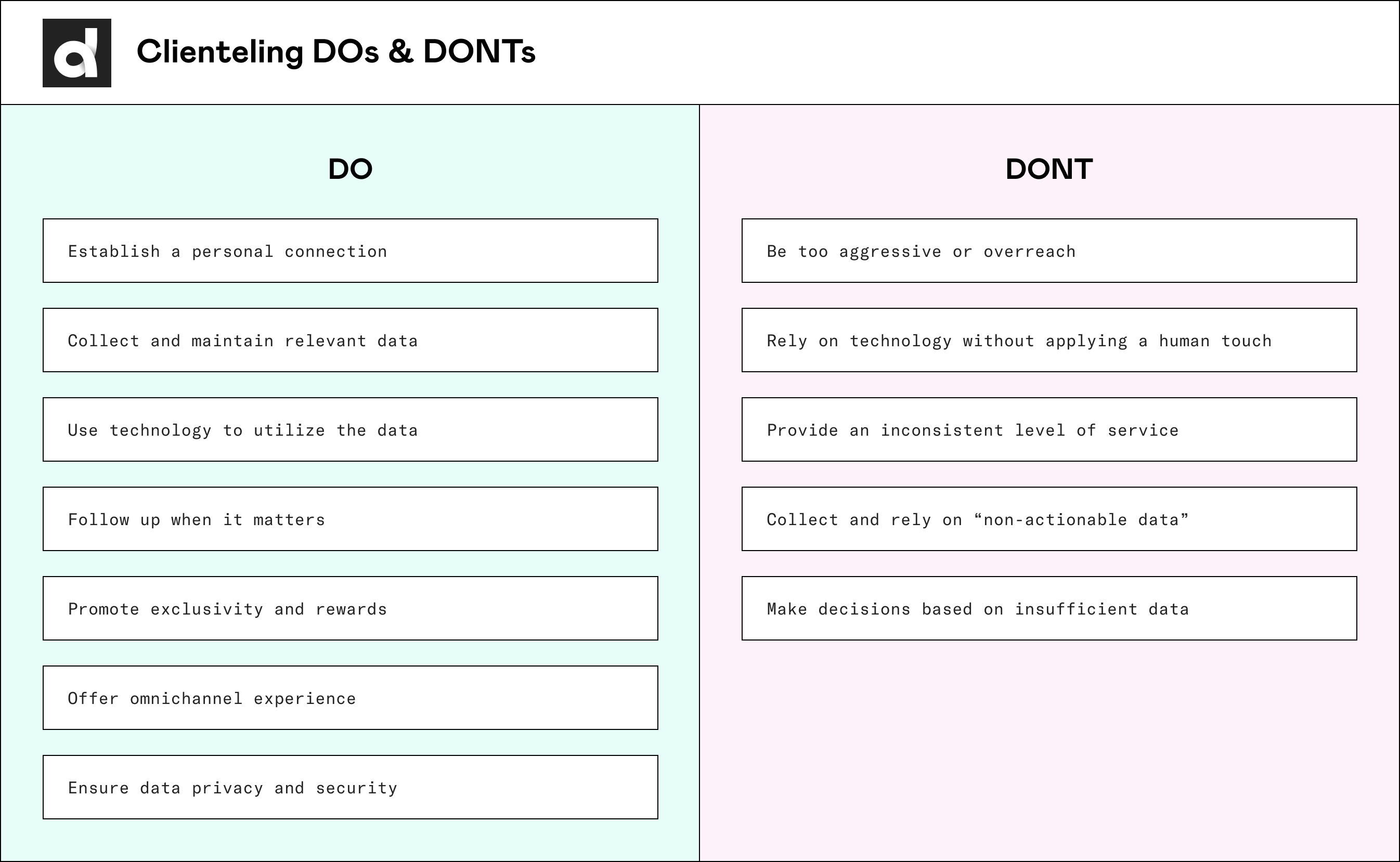14 Tips For Successful Retail - Clienteling Best Practices And Examples
April 19th, 2023 · Written by Anna Kondrasheva

Contents
These days, brands can’t imagine significantly boosting sales or improving their customer engagement without deploying the best in-store and online clienteling practices.
Retailers have used in-store clienteling for decades, and now, in the digital era, the personalized customer experience is even more critical. By unifying customer data and empowering sales associates with efficient clienteling tools, brands can create a unique and unforgettable shopping experience that will keep customers coming back for more.
In this post, we’ll share some practical tips and real-world examples of clienteling best practices and look at some tactics that might be counterproductive for building brand loyalty and promoting sales growth.
Clienteling Best Practices

1. Make It Personal
To provide exceptional customer service, it's essential to establish a personal connection with your repeat customers. Utilizing modern digital clienteling tools, you can easily manage and access customer data to personalize and target promotions and messages.
For first-time customers, take the initiative to introduce yourself and start a conversation to build rapport and gain insight into their preferences. By inputting this information into your CRM, you can create a detailed profile to enhance future interactions and further tailor your approach.
2. Collect And Maintain Relevant Data
Collecting relevant and valuable information about your customers is important to ensure successful clienteling. This can include their name, contact information, purchase history, preferences, and interests.
Collecting only the information that can be used to grow sales or promote customer loyalty is essential. Avoid asking too personal intrusive questions or collecting overly granular behavioral data. Collecting every action a customer takes on a website or in-store can be excessive. Focusing on the most critical actions that can inform the clienteling process is important.
By collecting and utilizing this data effectively, retailers can improve their understanding of their customers, build stronger relationships, and increase the chances of repeat business.
3. Effectively Personalize The Shopping Experience
Personalizing the shopping experience is a crucial aspect of clienteling. By using the customer data, sales associates can understand the customers' preferences, buying behavior, and interests, and provide personalized recommendations.
For example, a customer who has previously purchased a winter coat will likely be interested in gloves or scarves that complement it. A customer who has shown interest in a particular style can be offered similar products or collections.
4. Use Technology To Manage Data And Further Personalization With Targeted Outreach
Using technology is an essential component of successful clienteling. Modern digital clienteling tools allow retailers to collect and manage customer data in a more efficient and organized way. These tools enable retailers to keep track of their high-value customers and their preferences and send targeted promotional messages and emails.
Retailers can create more relevant and effective marketing campaigns by segmenting customers based on their interests, past purchases, and demographics. This helps to increase the chances of the customer making a purchase, as they are more likely to be interested in the products or services offered.
5. Follow Up
Following up with customers after their purchase is an important step in building a lasting relationship with them. It shows that you value their business and are committed to providing the best possible service. A simple thank-you message can go a long way in making the customer feel appreciated and valued.
In addition to expressing gratitude, following up with customers provides an opportunity to ask for feedback. You can use this feedback to improve the shopping experience for the customer. It can also help you identify areas for improvement and address any issues the customer may have experienced during their visit.
The follow-up method should be based on the customer's preference and the nature of the interaction. For example, a personalized phone call or note may be more appropriate if the customer has made a significant purchase. However, a thank-you email or text message may be sufficient for a minor purchase.
6. Continuously Measure Success
It is essential to analyze customer data regularly to identify trends and patterns. This data can help you better understand your customers' preferences and behaviors, which can then be used to create more personalized and targeted clienteling campaigns.
Regularly analyzing customer data ensures that your clienteling efforts remain relevant and effective over time.
7. Promote Exclusivity And Rewards
Creating a sense of exclusivity makes customers feel valued and appreciated, which leads to stronger emotional connections with your brand. Clienteling apps help to offer exclusivity and rewards effectively by identifying your highest-value customers and tailoring your offers to their needs and preferences.
For example, if you know that a customer frequently purchases a specific product or favors a particular style, you can offer them an exclusive discount on their next purchase. Alternatively, you can offer personalized promotions based on the customer's interests, their upcoming birthday, or a holiday relevant to them specifically.
These rewards can be offered through various channels, such as email, social media, or your website, and can be a powerful tool for building customer loyalty and increasing sales.
Consider offering customized gifts or packaging, complimentary refreshments, and organizing exclusive events relevant to your brand’s product.
8. Offer Omnichannel Experience
This means creating a seamless, integrated shopping experience for customers across all channels, both online and offline. To do this, retailers should use technology to bridge the gap between in-store and online experiences. For example, allowing customers to purchase products online and pick them up in-store or offering virtual bookings or virtual styling sessions with sales associates.
Giving customers the flexibility to shop how they want and when they want while still receiving personalized attention from sales associates can lead to increased customer satisfaction and loyalty and improved sales and revenue.
The technology used for omnichannel experiences is user-friendly and reliable. Integrating systems and processes must be seamless, with clear instructions and guidance for customers to make their shopping experience easy and enjoyable. Additionally, retailers should ensure their sales associates are adequately trained to use the technology and offer a consistent, personalized experience across channels. Depending on the brand and its needs, creating a customized clienteling solution that covers all points might be necessary.
9. Ensure The Privacy And Security Of Customer Data
Ensuring the privacy and security of customer data is of utmost importance in clienteling. Collecting and storing customer data comes with the responsibility of protecting it from breaches or misuse. This includes adhering to data protection laws, implementing secure data storage measures, and limiting access to customer data only to authorized personnel.
Transparency is also essential in maintaining customer trust. Retailers should communicate to their customers how their data is collected, stored, and used. They should provide options for customers to control their data, such as opting out of marketing communications or deleting their data altogether.
By prioritizing the privacy and security of customer data, retailers can build trust and loyalty with their customers and avoid potential legal and reputational risks.

Sales staff personalizing the customer experience in store
Excessive Or Unnecessary Practices - Examples Of “Overdoing” Clienteling
While clienteling can be a powerful tool for building strong customer relationships and driving sales, there is also the potential for going overboard with certain practices.
Overdoing clienteling can lead to a negative customer experience and damage your brand reputation. Sticking the right balance and avoiding excessive or unnecessary practices is vital. This section will explore some examples of overdoing clienteling and provide insights on avoiding them.
1. Being Too Aggressive
If the associate’s attitude in the store is too pushy and aggressive or outreach messages are persistent and spammy, it can be an immediate turn-off for the customer.
2. Relying On Technology Too Much
While technology can be a helpful tool for clienteling, overreliance on technology can be counterproductive. This can include using technology as a substitute for in-person interactions or failing to personalize recommendations based on customer preferences.
3. Providing Inconsistent Level Of Service
If a brand's clienteling techniques are inconsistent across all touchpoints, it can damage the customer relationship. This can include providing different levels of service based on the customer's spending habits or inconsistent communication across different channels.
4. Collecting “Non-Actionable” Data
Non-actionable data refers to information that cannot be used to improve the customer experience or inform business decisions. Brands must refrain from collecting data that is not relevant or useful in enhancing the customer experience or informing business decisions. Gathering data just for the sake of having it can be a waste of resources and potentially harm customer trust if they feel their privacy is being invaded.
5. Making Decisions Based On Contradictory Or Insufficient Data
Suppose a customer's purchase history indicates an interest in two different categories of products that don't have any apparent connection. In that case, it can be challenging to determine which category to focus on for future recommendations. In this case, collecting more data on the customer's purchasing habits and preferences may help to clarify the situation and make it easier to determine how to act on the data.
However, it is also possible that contradictory data may result from the customer's changing needs or interests or other factors that are difficult to predict or control. In any case, it is crucial for retailers to be aware of the potential for contradictory data and to have processes in place for analyzing and acting on it in a meaningful way.
Effective clienteling can be a game-changer for any retail business. Retailers can build strong customer relationships and increase sales and loyalty by collecting relevant customer data, personalizing the shopping experience, using technology, and offering rewards and exclusivity.
However, avoiding excessive or unnecessary clienteling practices is important, such as collecting non-actionable data or being too pushy with promotions. By avoiding these pitfalls and implementing these best practices, you can create a successful clienteling program that sets your business apart from the competition.
Have a project in mind?
Join our newsletter!
Get valuable insights on the latest digital trends, strategies, and developments in China and globally delivered straight to your inbox.